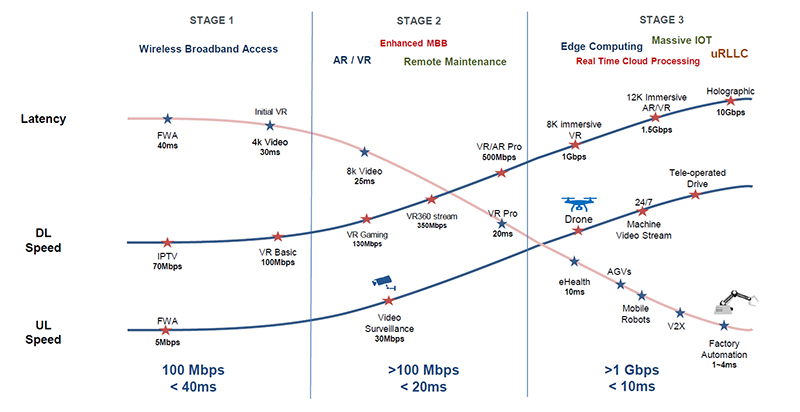The progressive emergence of 5G networks is shaping a new scenario for different industries on their way to digitization, allowing the implementation and development of a new set of applications aimed at increasing productivity and optimizing processes, achieving cost reduction and operational improvements.
These applications place new requirements on the network infrastructure, such as the need for real-time communication (low latency), transmission of large volumes of data, both in sending (Uplink) and receiving (Downlink) and the communication with a myriad of sensors (IoT), which combined with technologies such as edge computing, Big data and Artificial Intelligence (AI), will enable the implementation of remote control of machinery, autonomous and unmanned vehicles, real-time predictive maintenance and many other use cases that are part of the fourth industrial revolution, also known as Industry 4.0.
The following graph shows some of the values required by these applications, such as latency, Downlink (DL Speed) and Uplink (UL Speed). Depending on the sector, it will be required a higher or lower level of these parameters and, if the current values are different from the desirable values, the conclusion is unequivocally that the available resources are not sufficient and that a new network infrastructure is needed.
The private networks that are currently used have major disadvantages. Firstly, they offer poor performance in mobility and, because they use unlicensed frequencies, they are more exposed to interferences and cyber-attacks. They also involve higher costs, since the different services require independent networks and, due to that they use higher frequencies, a greater number of repeaters are required, increasing deployment and maintenance costs.
Thus, a technology such as Wi-Fi cannot meet the new demands of Industry 4.0, in terms of capacity, coverage, latency and interference.
Faced with this, private cellular networks support mobility natively, enabling seamless operation, and offer the highest levels of Quality of Service (QoS) required by these applications. In addition, they use licensed bands, which avoids interference and, by using lower frequencies, improves CAPEX and OPEX by requiring fewer sites. Finally, they are deployed as a standard and fully open technology, which translates into a free competitive market with a greater number of providers that encourage the evolution and incorporation of future applications within a clear and innovative framework.
In this way, private broadband networks offer multiple advantages for the different vertical industries:
- Self-management ensuring flexibility in production
- A fully standardized ecosystem that facilitates new application development
- Increased scalability
- Real-time monitoring
- QoS through a dedicated network for industrial applications
- Support for ultra-reliable, low-latency communication (URLLC)
- Maximum data privacy and security
- Protection of Know How, Production and Attentive Data
AN EXAMPLE, SMART MINING
Let’s look at the advantages in a specific scenario such as mining. Smart mining is aimed at improving processes through sensors and cameras. For example, autonomous vehicles prevent accidents and reduce fuel consumption, and this means for the company to increase productivity by 34% and also reduce costs by 13%, two basic objectives in the industrial process.
Real-time monitoring can increase equipment uptime by up to 150% and remote control of drilling equipment by 60%. The use of drones for certain tasks (safety, mapping) leads to cost reductions of up to 51%, and intelligent ventilation control not only reduces costs by 60%, but also improves air quality levels, which is absolutely essential in mining operations.
In such an environment, a private cellular network offers the transmission capacity and QoS levels needed to be the necessary communication channel for all these new services and applications.




